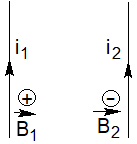
Two parallel wires are carrying electric currents of equal magnitude and in the same direction. They
Option:
A) a repulsive to each other
B) an attractive force to each other
C) no force to each other
D) a rotational torque to each other
Answer
220.2k+ views
Hint: In order to solve this question, we should know that a current carrying wire always produces a magnetic field around it and when two such wires are placed near each other their magnetic field either tends to attract or repel each other depending upon the direction of currents and can be explained by Fleming’s left hand rule.
Complete answer:
A current flowing through a metal wire creates a magnetic field. This magnetic field can be used to According to the question, we have given that Two parallel wires are carrying electric currents of equal magnitude and in the same direction.
Fleming’s left hand thumb rule explains when a current carrying conductor is placed in an external magnetic field, then that conductor experiences a force perpendicular to both the field and direction of the flow of current.
Now using the Fleming’s left hand thumb rule such that point your thumb in the direction of current and the curl of fingers will give the direction of magnetic field so, when two wires having current ${{i}_{1}}\,\And {{i}_{2}}$ in same direction then magnetic fields ${{B}_{1}}\,\And \,\,{{B}_{2}}$ due to both wires will be opposite in direction between them one is anticlockwise and other is clockwise and thus behaving like two opposite poles of a magnet.

And as we know opposite poles of a magnet attract each other, these two current carrying wires will also attract each other. and if there were currents in opposite directions then again due to left hand thumb rule we see that both magnetic fields will be in the same direction hence they will act as same poles and same poles of a magnet repel each other so these wires would have been repelled to each other.
Hence, the correct answer is option (B).
Note: If you run electricity through a wire, you create a magnetic field. This field can produce a force on another wire nearby. The magnitude of this force is proportional to the current in the first wire, the distance between the wires, and the permeability of the surrounding material. This force can be used to move objects or to generate electricity.
Complete answer:
A current flowing through a metal wire creates a magnetic field. This magnetic field can be used to According to the question, we have given that Two parallel wires are carrying electric currents of equal magnitude and in the same direction.
Fleming’s left hand thumb rule explains when a current carrying conductor is placed in an external magnetic field, then that conductor experiences a force perpendicular to both the field and direction of the flow of current.
Now using the Fleming’s left hand thumb rule such that point your thumb in the direction of current and the curl of fingers will give the direction of magnetic field so, when two wires having current ${{i}_{1}}\,\And {{i}_{2}}$ in same direction then magnetic fields ${{B}_{1}}\,\And \,\,{{B}_{2}}$ due to both wires will be opposite in direction between them one is anticlockwise and other is clockwise and thus behaving like two opposite poles of a magnet.

And as we know opposite poles of a magnet attract each other, these two current carrying wires will also attract each other. and if there were currents in opposite directions then again due to left hand thumb rule we see that both magnetic fields will be in the same direction hence they will act as same poles and same poles of a magnet repel each other so these wires would have been repelled to each other.
Hence, the correct answer is option (B).
Note: If you run electricity through a wire, you create a magnetic field. This field can produce a force on another wire nearby. The magnitude of this force is proportional to the current in the first wire, the distance between the wires, and the permeability of the surrounding material. This force can be used to move objects or to generate electricity.
Recently Updated Pages
Electricity and Magnetism Explained: Key Concepts & Applications

JEE Energetics Important Concepts and Tips for Exam Preparation

JEE Isolation, Preparation and Properties of Non-metals Important Concepts and Tips for Exam Preparation

JEE Main 2021 July 25 Shift 1 Question Paper with Answer Key

JEE Main 2021 July 22 Shift 2 Question Paper with Answer Key

States of Matter Chapter For JEE Main Chemistry

Trending doubts
JEE Main 2026: Application Form Open, Exam Dates, Syllabus, Eligibility & Question Papers

Understanding Uniform Acceleration in Physics

Derivation of Equation of Trajectory Explained for Students

Hybridisation in Chemistry – Concept, Types & Applications

Understanding the Angle of Deviation in a Prism

How to Convert a Galvanometer into an Ammeter or Voltmeter

Other Pages
JEE Advanced Marks vs Ranks 2025: Understanding Category-wise Qualifying Marks and Previous Year Cut-offs

Dual Nature of Radiation and Matter Class 12 Physics Chapter 11 CBSE Notes - 2025-26

Understanding Centrifugal Force in Physics

JEE Main Marking Scheme 2026- Paper-Wise Marks Distribution and Negative Marking Details

Degree of Dissociation: Meaning, Formula, Calculation & Uses

Ideal and Non-Ideal Solutions Explained for Class 12 Chemistry




